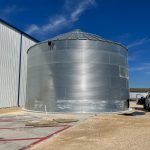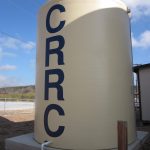“Why should I invest in a rainwater harvesting system, if there is no rain falling?”
“It needs to rain first before a rainwater collection system will be worth it.”
“Right now I would have an empty tank. This rainwater harvesting idea isn’t worth it.”
If there is a drought happening, these are typical responses that we hear from people when talking to them about rainwater harvesting. I guess it is just human nature in terms thinking short-term especially in our fast paced modern world.
Well, the simple truth is, in order to capture the rain when it does finally fall, you need to have an established rainwater harvesting system effectively set up prior to the first drop. Therefore a drought is a perfect time to think about rainwater harvesting.
So, it shouldn’t be “it needs to rain first”… it should be “I need a rainwater harvesting system first.”
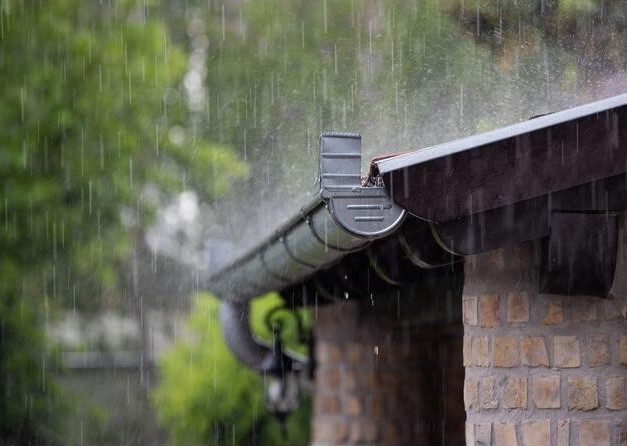
Being Proactive
“So when should I think about a rainwater harvesting system?”
There is a saying out there that perfectly answers this question…
The best time to plant a tree is twenty years ago. The second best time is now.
Source
So even though the drought is happening now, the past has proven that it won’t be like this forever on.
While we may not think of a drought as an opportunity to collect rainwater, it most certainly is a great time to plan your rainwater system. The specifics of designing, acquiring materials and installation can take many months from beginning to end. During this time of no rainfall, you can prepare to collect the rain as soon as it hits your roof. Planning ahead ensures that you are ready for the inevitable. It will rain again, and you will be ready!
Ultimately, it is about being proactive and getting on a better path forward for future water stressed times. It allows you to create better systems and habits to reduce your water use.
Rain Falls Even During a “Drought”
Even during droughts, regions still receive rainfall. For example, in Austin, Texas, during the “drought of record” for Texas during the years 1950 to 1957, Austin received a good amount of rainfall. See the graph below. Note that the average annual rainfall for Austin, Texas, is about 32 inches. What you are not seeing from this data is the spatial or temporal nature of the rainfall. In addition, drought typically happens over a large region, not just one city.
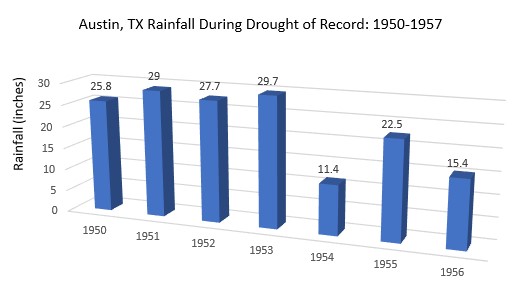
Source: NOAA Climate Data Online
Even if we look at the new “drought of record” for Texas during the years of 2008 to 2015, you see the same phenomenon… you still get rainfall, even during a drought.
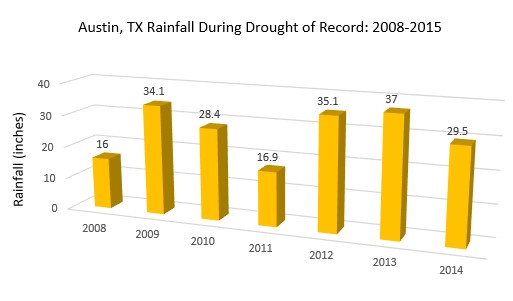
Source: NOAA Climate Data Online
Actually, you could even say that rainwater may be more precious during drought periods. If you receive lower amounts than average, coupled with the potential of very large rain events with long dry periods between them, having a rainwater harvesting system in place, can help you buffer those dry times.
For example, in August of 2022 (during one of the driest years on record), Austin received upwards of 10 inches of rain in a 24-hour period at one point. If you had a rainwater harvesting system with a 1,500 square foot collection area during that event, you would have been able to capture over 9,000 gallons of rainwater in just that one rain event.
If you would like to calculate the potential rainwater collection volumes from your own roof, check out our rainwater harvesting calculator.
Overcoming the “Water Cycle of Apathy”
So during times of drought, the public’s attention is focused on the problem with the increased news stories, social media posts, and water agency mailings. But enviably, when the rains come back and the focus on drought goes away, so does people’s attention on water conservation.
The image below perfectly captures this sentiment.
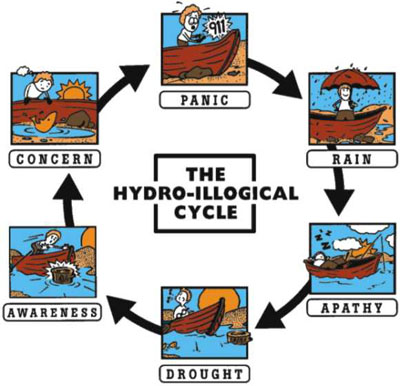
Source: National Drought Mitigation Center
When times are good (rain), it is easy to roll with the good feelings and not worry about the future. This leads to inaction (apathy). But inevitably, things change and the good times don’t last forever (drought). This presents a wake-up call for people (awareness). You start to worry about the situation and reminisce about the good times (concern). If the “bad times” continue this leads to feelings of alarm (panic). If we aren’t careful, the cycle can begin again without us learning anything from the previous cycle.
So we should learn from the past hydro-illogical cycles and invest in water conservation for the future. This way we may be able to buffer the extremes of the next drought or at least continue to have a source of water for your irrigation needs or even your potable, indoor needs.
Great Educational Opportunity
A drought can bring a more acute personal awareness of water use. With the water conservation messaging you may be receiving from your local water provider and other media outlets, you start to focus your attention on your water use and how to reduce it.
Rainwater harvesting systems are great educators the connect you more deeply with the water cycle. When you have a rainwater cistern that you use for irrigation purposes, you can actively see how much water you use with the declining water levels in your cistern. You get a glimpse of what it takes to keep your landscape supplied with the water it needs. Without a rainwater collection system, you just open up your municipal water hose bibb or turn on your automatic irrigation system. Then you get your water bill, typically 15 to 30 days after you use the water. Unless you have a time machine, you can’t change your past water use.
Therefore, a rainwater harvesting system binds you more closely with the water cycle and allows you to make immediate changes in how you use water around your house.
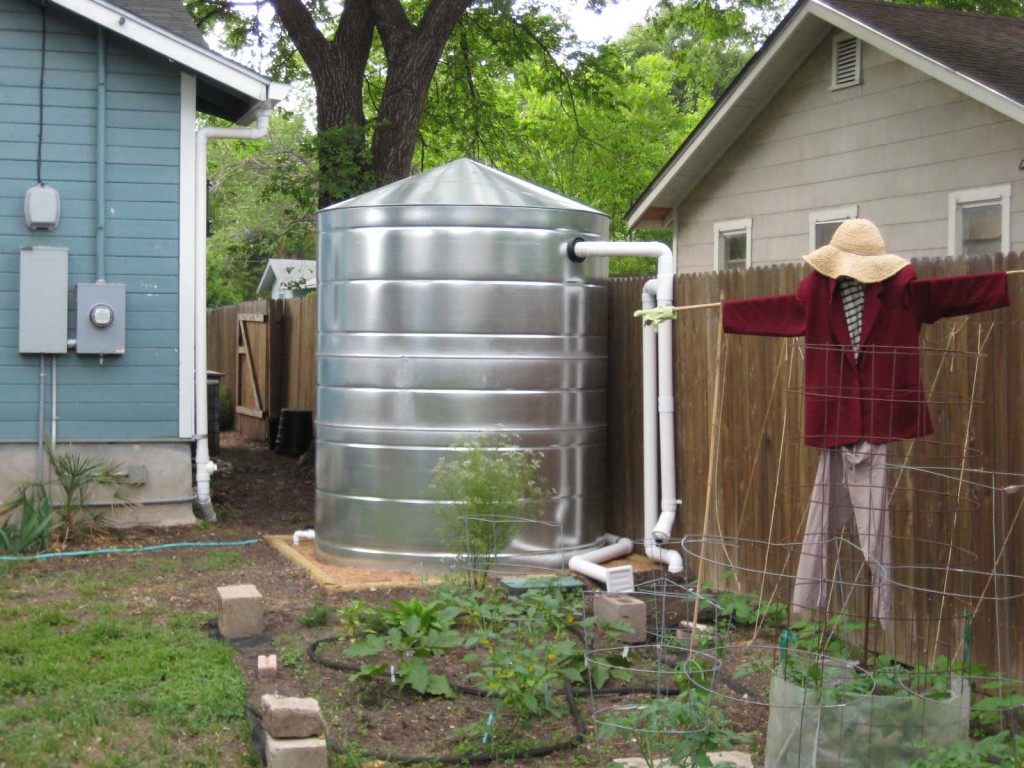
Building Resiliency
Resilience is a popular topic right now as communities across the US and world battle climate change issues. Becoming more resilient to potential climate and weather changes can help prevent damage to our communities and reduce the future costs of this damage.
Rainwater harvesting can help reduce the environmental impact of water consumption. Municipal water systems require energy to transport, treat and distribute water. By harvesting and using rainwater, you reduce the demand for municipal water, which helps reduce energy consumption and associated greenhouse gas emissions.
In addition, rainwater harvesting can also help make your community more resilient to flooding. By harvesting rainwater, you can reduce the amount of stormwater runoff that goes to sewers and streams. This helps in reducing the quantity of stormwater runoff which can cause flooding and it helps in reducing the pollutant impacts of this stormwater in our local streams and rivers.
In urban environments, impervious cover produces a higher rate of runoff versus natural environments. Rainwater harvesting in urban environments can help to reduce this runoff and to allow you to slowly infiltrate rainwater into the soil as you water your landscaping over time.
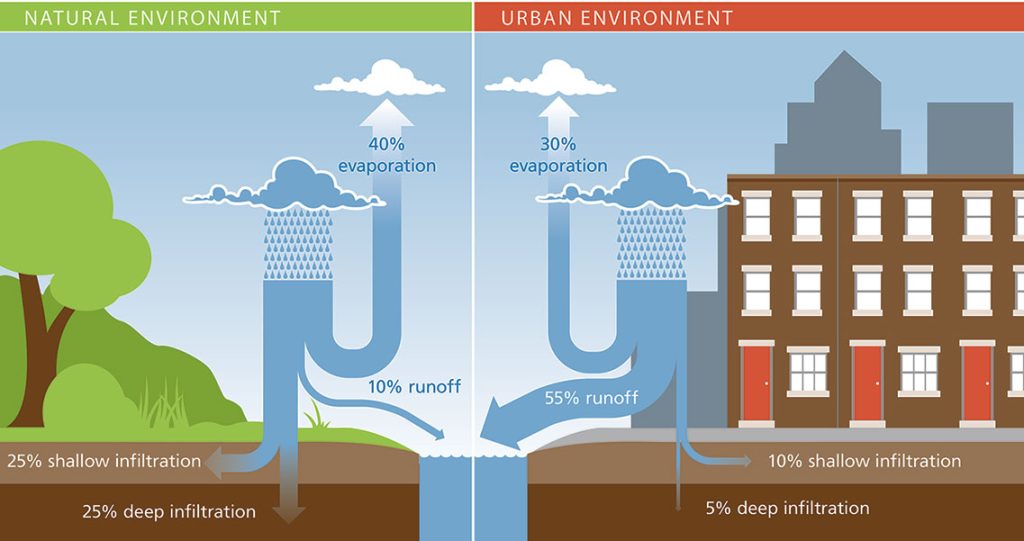
Go Small or Go Big
Another reason to consider rainwater harvesting during a drought is that it can be so easy. At the simplest level, all it takes is purchasing a rain barrel and installing it on one of your existing downspouts. Then, of course, you just wait for the rain but at least you are ready.
Above this, adding larger volume of rainwater storage can be easy as well. As long as you have the physical space for the cistern (and you have an access path to get the cistern into that spot), it can be easy to install.
One of the biggest advantages of rainwater harvesting is that it allows people to collect and STORE water during periods of heavy rainfall, which can then be used during times of drought. This is an important note. This ability to store rainwater becomes all the more important as your region moves into a drought period.
With the potential for long dry periods during a drought though, one way to ensure you have adequate volume of rainwater over time is to think BIG. The bigger your rainwater harvesting cistern is, the more volume you can potentially collect. Higher volume allows for the cistern to fully fill during the rain events and provide the longevity to last through the drought.
But you also need to remember that harvesting rainwater doesn’t just mean collecting it into a cistern. You can harvest rainwater within your landscape through green infrastructure ideas such as rain gardens, swales, and terraces. This is called “passive harvesting” whereas collecting rainwater into a cistern is called “active harvesting”. It could be a perfect time to redo your landscape especially if portions of it has not stood the test of the drought.
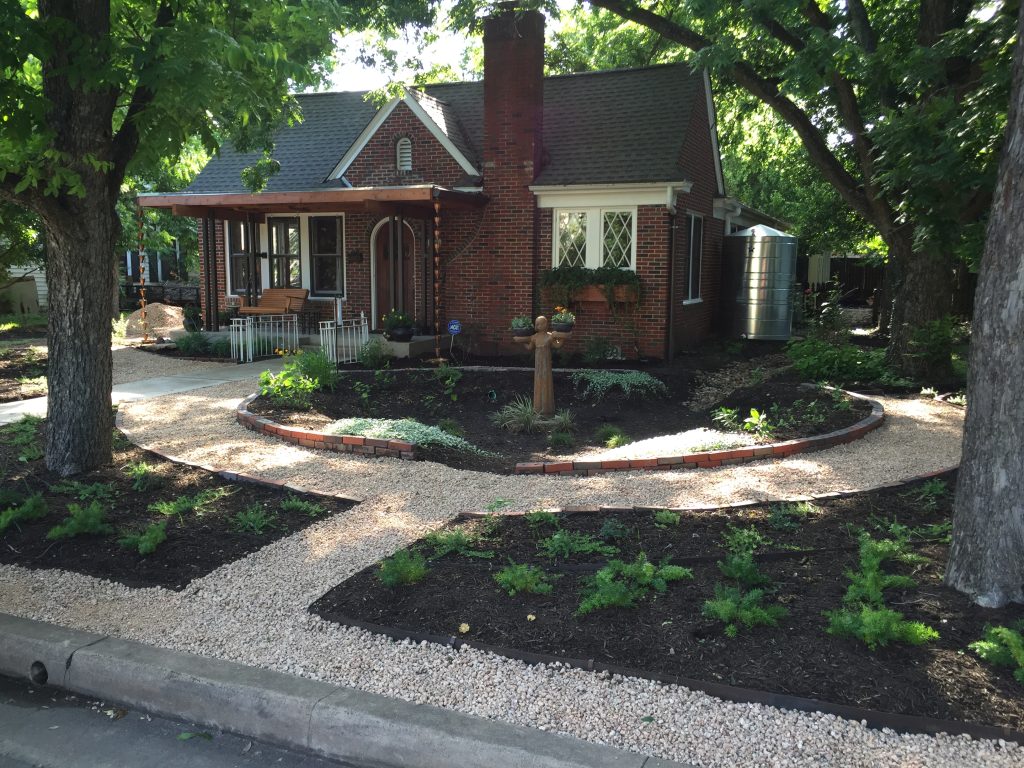
Why not combine the ideas of passive and active rainwater harvesting?
Start Planning TODAY!
Hopefully you have learned that rainwater harvesting during a drought is one of the best water conservation practices that you can implement.
Before the practice of rainwater harvesting can truly be worthwhile though, you need the rainwater harvesting system in place. As you have seen above, it is a fallacy to say that we need rain before harvesting it is worthwhile.
Something else to consider is that, as with the price of everything we consume, the construction prices of rainwater harvesting systems won’t get cheaper in the future. So get going and start collecting rainwater and watch your return-on-investment just get better and better over time.
Consider planning your rainwater harvesting system, even when the skies are clear. Proactive planning produces positive results!
Contact us TODAY to start planning your rainwater harvesting system!


